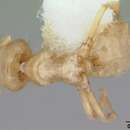en
names in breadcrumbs


The few Costa Rican records of this species are from cloud forest habitats. Workers have been collected in Winkler samples of sifted leaf litter from the forest floor.
This species has a wide range across tropical South America, and has been recorded occurring as far north as Barbabos and Costa Rica. Costa Rica: Monteverde, Volcan Barva transect at 1100m.
At La Selva Biological Station in Costa Rica, A. exsanguis and A. keira co-occur. The workers of A. exsanguis are scruffier, with somewhat more abundant dorsal pilosity. The males are more distinct, with males of A. keira having larger apices of the penis valves. A few worker collections from higher elevations above La Selva and in Monteverde are larger than the typical La Selva A. exsanguis and are tentatively identified as A. goeldii. LaPolla also described A. palaga, with workers indistinguishable from A. goeldii, based on a collection from Estrella Valley in the Atlantic lowlands and a collection from Alajuela.
North of Costa Rica, a few collections have associated males, and these more or less match La Selva A. exsanguis. Longino uses A. exsanguis as the default identification for A. exsanguis-like material from Nicaragua to Mexico, but it is likely that multiple cryptic species occur.
Taxonomic history
Combination in Rhizomyrma: Forel, 1912j PDF: 60.Combination in Acropyga (Rhizomyrma): Emery, 1925d PDF: 29.Junior synonym of Acropyga decedens: Costa Lima, 1931 PDF: 7.Status as species: Forel, 1895b PDF: 107; Forel, 1912j PDF: 60; Emery, 1925d PDF: 29; Borgmeier, 1927c PDF: 137; Wheeler, 1935f PDF: 327; Donisthorpe, 1936b PDF: 110 (in list); Weber, 1944b PDF: 93 (redescription); Kempf, 1972b PDF: 17; Bolton, 1995b: 57; LaPolla, 2004a PDF: 49 (redescription); Wild, 2007b PDF: 27; Guénard & Economo, 2015 10.11646/zootaxa.4040.2.8: 227; Wetterer et al., 2016 PDF: 5; Fernández & Ortiz-Sepúlveda, 2019 PDF: 732.Senior synonym of Acropyga borgmeieri: LaPolla, 2004a PDF: 49.Senior synonym of Acropyga goeldii columbica: LaPolla, 2004a PDF: 49.Senior synonym of Acropyga marshalli: LaPolla, 2004a PDF: 49.Senior synonym of Acropyga pachycera: LaPolla, 2004a PDF: 49.Senior synonym of Acropyga pickeli: LaPolla, 2004a PDF: 49.Senior synonym of Acropyga quadriceps: LaPolla, 2004a PDF: 49.Senior synonym of Acropyga rutgersi: LaPolla, 2004a PDF: 49.Senior synonym of Acropyga goeldii tridentata: LaPolla, 2004a PDF: 49.Senior synonym of Acropyga trinitatis: LaPolla, 2004a PDF: 49.[[ worker ]]. L. 2 a 2, 3 mill. Mandibules presque droites, armees de 3 a 4 dents, lisses, tres luisantes, avec 3 a 4 gros points enfonces. Tete a peu pres rectangulaire, plus large que longue, un peu plus large devant que derriere. Les yeux sont tres petits, composes de deux ou trois facettes atrophiees, situes au tiers anterieur des cotes de la tete. Epistome tres court, conforme du reste comme chez VA. smithii , ainsi que les aretes frontales et l'aire frontale. Pas de sillon frontal. Le scape des antennes depasse legerement le bord posterieur de la tete. Le funicule a de neuf a dix articles, dont le dernier est renfle et presque aussi long que les 4 precedents reunis.
Thorax comme chez l' A. acutiventris . Pronotum legerement concave longitudinalement. ' Mesonotum grand et assez eleve. Une echancrure tres distincte entre le mesonotum et le metanotum. Ce dernier arrondi;. sa face declive beaucoup plus longue que la face basale. Ecaille assez etroite, ovale-rectangulaire. Pattes assez courtes, un peu embrassantes.
Lisse, luisante, tres finement et regulierement ponctuee. Une pilosite dressee, d'un jaune pale, tres fine, pointue, de longueur irreguliere, assez abondamment repandue sur tout le corps qui est revetu en outre d'une pubescence jaunatre adjacente d'abondance mediocre (un peu plus abondante sur l'abdomen). Les tibias et les scapes n'ont qu'une pilosite tres courte, oblique sur les premiers, dressee sur les derniers.
Canindeyú (ALWC, MHNG). Literature records: Alto Paraná (Emery 1906 [as “ pachycera ”]).